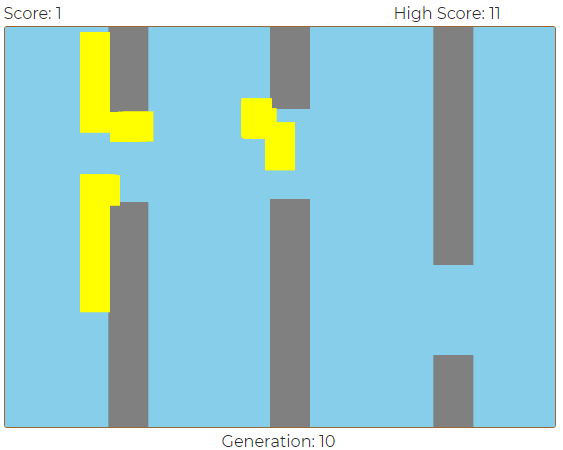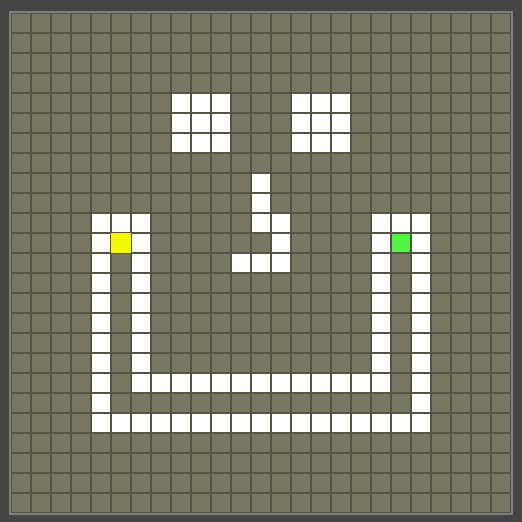Projects
Card Game Webserver

We were faced with a problem: in Terraforming Mars, you must shuffle several hundred cards together to form the deck, and more cards with each expansion. It was getting ridiculous. I wanted to make a simple simulation that would handle all of the cards for us while we played the game. This project did not go that route.
Instead, I simplified it to allow us to play another home favorite, Hearts. I currently have a rudimentary frontend, but a fully robust backend that makes use of Websockets, goroutines and channels to have fully asynchronous gameplay that allows a player to reconnect when they lose connection, while still keeping track of the connections to close any threads that are no longer in use. It was quite the challenge!
I suspect the next improvements to this will be a stab at React for a decent front facing experience, and to add more games to be able to play (maybe Terraforming Mars will make a return).
Jumpy Bird AI

I wanted to experiment with my newfound knowledge in AI from various sources like CodeBullet on YouTube and my Intro to Artificial Intelligence class at RIT, and I asked myself, "what's the simplest, yet still interesting project I can reasonably complete?" The result was an artificial intelligence that plays Flappy Bird- a game with one output, whether or not to jump.
I decided to implement it with a neural network. After realizing that there is no "right answer" to the network, I knew that the network needed to be trained somehow, and decided on a genetic algorithm. How many layers are in the network, what inputs are used, learning rates, population size per generation, all of these attributes are able to be modified before starting to see what AI training method gets to 1,000,000 points the fastest!
Slider Game

Slider is a game that I originally created for my senior project in high school. My only objective was to make a game, any game. And that's exactly what I did! After a short foray into C++, I decided that I should probably choose something more achievable for my skill level. I made a small game using a grid and a character that moves in straight lines, sliding until reaching a solid object, and passing between and over obstacles like lava, switches, and teleporters to make the puzzle game a little challenging. The original game was created in Python 2.12 and with a graphics library called PyGame. Unfortunately, this made the game difficult to show to my friends and family. For this reason I chose to port the game to the web using Javascript.
During freshman year of college, I learned about graphs and breadth-first search in CS2. I thought that would be perfect to apply to my old project for finding the shortest solution to each of my hand-crafted levels. It actually found a shorter solution for my 11th level!
Shakesearch
In my search for a career post graduation, I found a post on Reddit that asked for work on a project to see results. I thought, hey, I need experience doing web frontends and backends quickly, might as well just get this one going.
The result is Shaksearch. It was requested to enhance a barebones Shakespeare search engine to what we thought a user would like, and I think I did a pretty good job. If you check out the Github repo for this project, you will see my thought process as I was doing this.
NOTE: I am currently not hosting this because I am on AWS free tier, and it uses quite a bit of memory to hold the entire works of Shakespeare.
Website
This website has gone through several iterations. First, it was simply a static webpage for hosting my projects like my very first project, the slider game. I learned these skills during my first semester at RIT in my web dev class, which taught me the basics like HTML and CSS.
The next iteration was after I started learning PHP. This was during my first internship/coop at More Vang where the backend was primarily written in PHP, and used the Laravel framework. I decided to go a different route with my website and make it simple- I used CodeIgniter, a very small framework. This was the iteration that created the visual design (CSS becomes much easier to handle with Sass) and the blog that sits on a SQL database, which can be updated via API routes.
The current iteration rewrites the PHP framework into Go, making comparatively few frontend changes. Additionally, I migrated the website to Google Cloud services, which worked until it didn't and I switched to AWS. This allowed me a much greater flexibility in how I work with the backend, although it forces me to set everything up myself. To do this, I used Docker to containerize my Go website, and Docker Compose to instantiate it with a persistent store Postgres container as my database.